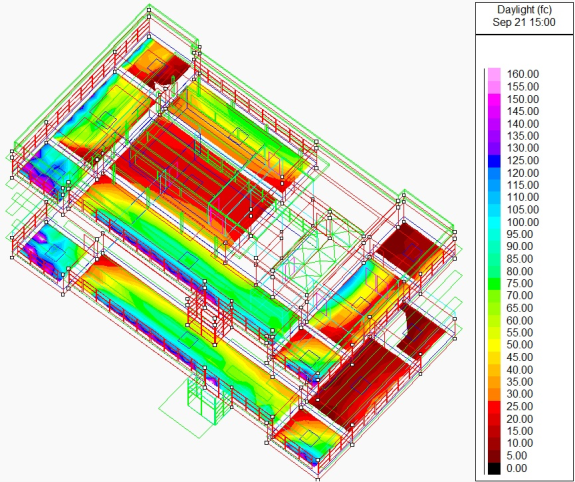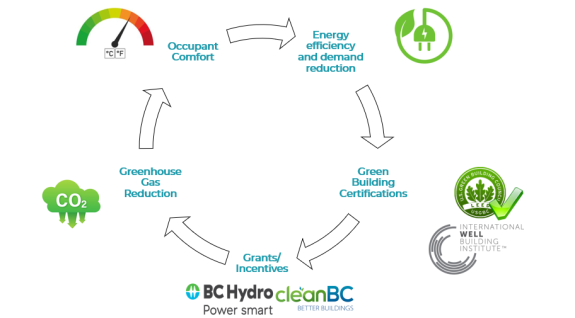In today’s rapidly evolving world, the significance of sustainable practices in building design cannot be overstated. As the demand for energy-efficient and environmentally friendly buildings continues to grow, energy modelling has emerged as an invaluable tool across the board for architects, engineers, designers, and developers. By simulating and analyzing a building’s energy consumption, energy modelling plays a crucial role in optimizing energy efficiency, reducing carbon footprints, and ensuring long-term sustainability across all building types.
Energy modelling uses computer-based simulation software to perform detailed annual analysis of a building’s energy use and energy-using systems. The graphic below shows the primary inputs required to complete an energy model.

This article explores the importance of energy modelling during building design and highlights the benefits it brings to the table.
Enhancing Energy Efficiency: Energy modelling enables designers to evaluate various design options and make informed decisions to maximize energy efficiency. By simulating a building’s energy performance under different conditions, such as climate, orientation, materials, and systems, designers can identify potential energy-saving measures. This analysis helps in optimizing insulation, glazing, lighting systems, and HVAC (heating, ventilation, and air conditioning) systems, leading to substantial reductions in energy consumption and operational costs throughout the building’s lifecycle.

Environmental Sustainability: In the face of pressing environmental concerns, energy modelling serves as a powerful tool to mitigate the environmental impact of buildings. By accurately predicting energy consumption, energy modelling allows designers to assess the building’s carbon footprint and identify opportunities for improvement. By incorporating renewable energy sources such as solar panels into the energy model, designers can evaluate the feasibility and potential energy generation. This integration promotes the integration of clean and renewable energy solutions, further reducing greenhouse gas emissions and fostering sustainable development.
Cost Savings and Economic Viability: Energy-efficient buildings not only contribute to a greener environment but also offer substantial cost savings over their operational lifetime. Energy modelling enables designers to conduct life cycle cost analyses, comparing different design options and their associated energy consumption. By considering factors such as initial construction costs, operational expenses, and maintenance costs, energy modelling helps identify the most economically viable solutions. This approach empowers stakeholders to make informed decisions and invest in energy-efficient technologies that result in long-term financial benefits.
Optimal Comfort and Occupant Well-being: Energy modelling not only focuses on reducing energy consumption but also ensures optimal comfort for building occupants. By simulating factors such as indoor air quality, thermal comfort, and natural lighting, energy modelling helps designers create spaces that are conducive to human well-being. By optimizing HVAC systems, designers can maintain consistent temperatures, minimize drafts, and enhance ventilation, thereby promoting a healthy and comfortable environment for occupants.


Regulatory Compliance, Certifications and Funding: With the rise of sustainable building certifications, such as LEED (Leadership in Energy and Environmental Design), Zero Carbon Building Design Standard, Well Building Standard, and energy-efficient based funding opportunities such as Canadian Mortgage and Housing Corporation’s MLI Select Program, Clean BC’s Commercial New Construction Program, and Fortis BC’s Commercial New Construction Performance Program, energy modelling has become an essential requirement for achieving code compliance, globally recognized certifications and financial funding for projects. Energy modelling helps architects and designers meet the strict energy performance criteria set forth by the building code, certifications standards and funding programs. By integrating energy modelling early in the design process, potential design flaws can be identified and rectified, ensuring compliance and enhancing the overall quality of the building.
Energy modelling is a vital component of contemporary building design, promoting sustainability, energy efficiency, and occupant comfort. By utilizing advanced software tools and simulations, architects and designers can optimize the building’s energy performance, reduce environmental impact, and improve economic viability. As the demand for green buildings continues to surge, energy modelling will remain a fundamental practice in creating a sustainable built environment. By embracing energy modelling, stakeholders can pave the way for a future where sustainable buildings become the norm rather than the exception, fostering a greener, more energy-efficient world for generations to come.

Take a look at Edge’s project portfolio here to see a sample of projects where we have been able to use the powerful tool of energy modelling to inform project teams throughout the building design process.
One comment on “Energy Modelling: Empowering Sustainable Building Design”
Comments are closed.